Welcome to Wuhan Yoha Solar Technology Co., Ltd!
common problem
Site Map
Language:
 Chinese
Chinese
 English
English
Welcome to Wuhan Yoha Solar Technology Co., Ltd!
common problem
Site Map
Language:
 Chinese
Chinese
 English
English
In the photovoltaic industry, performance testing of solar modules is a crucial step in ensuring product quality and efficiency. The solar module IV tester, as a professional piece of equipment, is widely used in production, research and development, and quality control processes. This article delves into the basic functions of solar module IV testers to provide readers with a comprehensive understanding of their core role. The basic functions of these testers encompass not only the measurement of fundamental electrical parameters but also performance evaluation and defect detection, among other aspects. By mastering these functions, companies can optimize production processes and enhance module reliability. Below, we will provide a detailed analysis of the basic functions of solar module IV testers.
What is a Solar Module IV Tester?
A solar module IV tester is a specialized device used to measure the current-voltage (IV) characteristics of solar modules. It precisely tests the electrical performance of modules by simulating real light conditions. The basic function of the IV tester begins with plotting the IV curve, which is the foundation for evaluating the output characteristics of a module. Typically integrated into production lines or laboratory environments, this device can provide test data quickly and accurately. Understanding the basic functions of the solar module IV tester is essential for the selection and application of photovoltaic equipment. With advancements in PV technology, the basic functions of IV testers continue to be optimized to meet higher testing standards.

Basic Function 1: IV Curve Measurement and Analysis
The core basic function of the solar module IV tester is the measurement of the IV curve. The IV curve reflects the current output of a solar module at different voltages and is a direct indicator for assessing module performance. The tester applies a variable load, records current and voltage data in real-time, and generates a complete IV curve. This process reveals key parameters such as the Maximum Power Point (MPP), Open-Circuit Voltage (Voc), and Short-Circuit Current (Isc). The basic function of the IV tester demonstrates high precision and stability in IV curve measurement, ensuring data reliability. Furthermore, this function can identify curve anomalies, such as steps or insufficient smoothness, thereby indicating potential issues. Through IV curve analysis, the basic function of the IV tester provides a basis for module grading and optimization.
Basic Function 2: Key Electrical Parameter Testing
The basic functions of the solar module IV tester also include precise testing of key electrical parameters. These parameters directly reflect module performance and mainly include Open-Circuit Voltage (Voc), Short-Circuit Current (Isc), Maximum Power Point Voltage (Vmpp), and Maximum Power Point Current (Impp). Under Standard Test Conditions (e.g., STC), the tester quickly measures these values and compares them with theoretical values. The basic function of the IV tester ensures the repeatability and accuracy of parameter testing, which is particularly important for quality control in mass production. For example, the open-circuit voltage test can verify the series resistance condition of the module, while the short-circuit current test reflects the efficiency of photogenerated current. The basic function of the IV tester significantly improves efficiency through automated testing processes.
Basic Function 3: Performance Evaluation and Efficiency Calculation
Performance evaluation is an important component of the basic functions of the solar module IV tester. Based on IV curve data, the tester can calculate indicators such as the Fill Factor (FF) and conversion efficiency. The Fill Factor reflects the optimization level of the module's output power, while the conversion efficiency directly measures the module's ability to convert light energy into electrical energy. Through built-in algorithms, the basic function of the IV tester calculates these parameters in real-time and provides intuitive reports. This function helps users quickly identify high-performance modules while weeding out low-efficiency products. In performance evaluation, the basic function of the IV tester also considers the effects of temperature coefficients and irradiance, ensuring test results are close to real-world applications. Through this function, companies can achieve product standardization and enhance competitiveness.
Basic Function 4: Defect Detection and Quality Control
The basic function of the solar module IV tester plays a key role in defect detection. By analyzing the shape of the IV curve and parameter deviations, the tester can identify common module defects such as hot spots, micro-cracks, or Potential Induced Degradation (PID). For instance, localized depressions in the IV curve may indicate cell damage. Combined with high-sensitivity sensors, the basic function of the IV tester can detect minor performance changes, providing early warnings of quality issues. This function is applicable not only to end-of-line testing in production but also to regular maintenance and fault diagnosis. Through comprehensive quality control, the basic function of the IV tester helps reduce product return rates and safeguards brand reputation.
Other Related Functions: Temperature Compensation and Data Analysis
In addition to core testing, the basic functions of the solar module IV tester extend to temperature compensation and data analysis. Temperature significantly affects module performance; testers are usually equipped with temperature sensors for automatic temperature compensation, ensuring test results are comparable under standard conditions. Simultaneously, the basic functions include data storage, export, and visual analysis, supporting long-term trend monitoring. Users can view historical data and perform statistical comparisons through the software interface, thereby optimizing production processes. In these additional features, the basic functions of the IV tester demonstrate advantages in intelligence and integration.
Conclusion
In summary, the basic functions of the solar module IV tester cover multiple aspects, including IV curve measurement, key parameter testing, performance evaluation, and defect detection. These functions collectively ensure the reliability and efficiency of solar modules and are crucial for the high-quality development of the photovoltaic industry. As technology evolves, the basic functions of solar module IV testers will continue to be upgraded, providing stronger support for businesses.
This article has provided a detailed analysis of the basic functions of solar module IV testers, hoping to serve as a valuable reference for industry peers. If you are interested in related equipment, please stay tuned for our subsequent updates. The basic functions of the solar module IV tester are the cornerstone of the photovoltaic testing field, and their importance cannot be overlooked.
keywords:TOP
18086473422
MESSAGE
